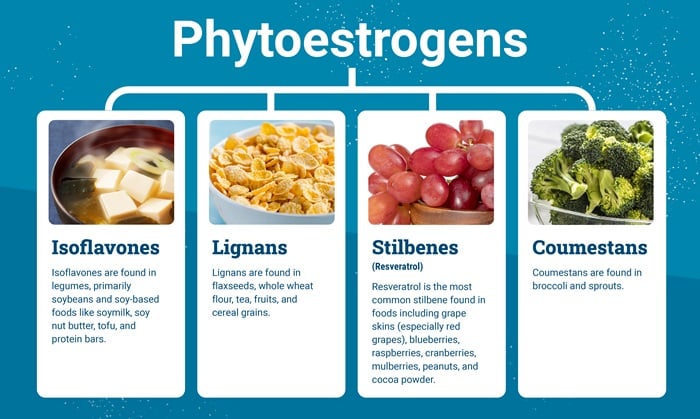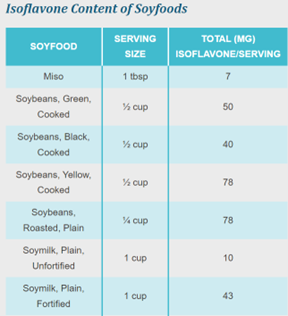Exploring the Relationship Between Soy, Phytoestrogens, and Estrogen
Despite its growing popularity, certain misconceptions about soy still exist. The most common area of interest pertains to the presence of phytoestrogens in soy and their potential impact on both women and men’s health. Read more to learn about the relationship between soy, phytoestrogens, and estrogen.
What Are Phytoestrogens?
Phytoestrogens are naturally occurring polyphenolic compounds found in plants, especially in legumes like soybeans. They have been extensively studied for their role in human health, such as cardiovascular health, bone health, breast cancer, and menopausal symptoms. There are a few common groups of phytoestrogens found in foods.
- Isoflavones: Isoflavones are compounds found in legumes, primarily soybeans and soy-based foods such as plant-based meat alternatives, soymilk, soy nut butter, tofu, and protein bars. The main soy isoflavones are daidzein and genistein. Daidzein is also found in kudzu root, an ingredient in some supplements. Naringenin, a precursor to genistein, is found in some citrus fruits.
- Lignans: Lignans are found in flaxseeds, sesame seeds, whole grains, tea, and fruits.
- Stilbenes (Resveratrol): Resveratrol is the most common stilbene found in foods including grape skins (especially red grapes), blueberries, raspberries, cranberries, mulberries, peanuts, and cocoa powder.
- Coumestans: Coumestans are found in broccoli and sprouts.

The Difference Between Phytoestrogens vs. Estrogen
Estrogen, commonly referred to as the female sex hormone, is produced mainly by the ovaries and travels through the bloodstream to interact with tissues. Men also produce estrogen, as it is secreted by the adrenal gland and the testes.
For women, estrogen is crucial to the reproductive function and menstrual cycle. In premenopausal women, estrogen levels rise suddenly halfway through the cycle, which triggers the release of an egg. This level then quickly decreases after ovulation. Estrogen is also responsible for the growth of breasts during adolescence, contributes to bone strength, and improves the thickness and quality of skin. After menopause, the ovaries produce very little estrogen, so blood estrogen levels decrease.
While women generally have higher estrogen levels, older men may have higher blood estrogen levels than older women. The presence of estrogen in men is also important for heart, bone, and brain health – however, men need estrogen in much smaller amounts.
Are Phytoestrogens the Same as Estrogen?
Phytoestrogens share some structural similarities with human estrogen but do not function the same.
One example of this: isoflavones, a common type of phytoestrogen, binds to estrogen receptors in cells differently from the way human estrogen does. This can impact the body in different ways.
Soy Isoflavones and Women’s Health
When it comes to women’s health, isoflavones in soy foods may have several potential health benefits, from improving symptoms of menopause to reducing risk of breast cancer.
.png?sfvrsn=541eaa27_0&MaxWidth=600&MaxHeight=700&ScaleUp=false&Quality=High&Method=ResizeFitToAreaArguments&Signature=53B1E9847616E3D67E8F9277C2B1A402054DBC4E)
1. Isoflavones and Menopause Symptoms (Hot Flashes)
Since 1995, more than 50 clinical trials have researched the impact of isoflavones, derived from different food sources, in relieving hot flashes associated with menopause.
For example, a systematic review and meta-analysis of 36 studies was conducted to determine if soybean isoflavones help to alleviate hot flashes in menopausal women, which revealed that:
- Consuming 30 to 80mg of soy isoflavones reduced the number of hot flashes per day by about 21% more than the placebo group.
- Soy isoflavones also reduced hot flash severity by about 26% compared with the placebo group.
- In addition, isoflavone supplements containing more than 18.8 mg of genistein were over twice as effective in reducing the frequency of hot flashes compared to supplements with lower levels of genistein.
As this was a meta-analysis, the study relied on the published work of others, presenting unique limitations such as some studies have limitations in their methodology which could impact the results.

2. Isoflavones and Breast Cancer
Since the 1990s, researchers have conducted human clinical trials investigating the protective effects of soy foods and isoflavones against breast cancer. The interest in this topic can be attributed to the historically low breast cancer mortality rates in Asian countries where soy consumption is prevalent.
Additionally, there is interest in exploring the potential of soybean isoflavones to act as anti-estrogens. These compounds have the ability to potentially block the impact of estrogen on breast cancer cells, thereby slowing their growth.
Misconceptions regarding the impact of soy on breast cancer can be linked to a series of animal studies. However, it has been found that rodent studies are an inaccurate approach to assess soy consumption, as mice have different metabolism processes compared to humans.
Human studies have indicated that isoflavones, present in soy foods, may offer protection against breast cancer. While studies have reported mixed findings some have shown promising results, and leading health organizations have also weighed in on the matter:
- A meta-analysis of epidemiologic studies found that higher soy intake, which was about 20 mg of isoflavone per day, was associated with a 29% reduction in the risk of developing breast cancer. However, some evidence indicates that to derive this benefit, soy consumption must occur during childhood and/or adolescence.
- Research has extensively studied the effect of soy intake on various established markers of breast cancer risk, such as mammographic density and in vivo breast cell proliferation. The findings indicate that the intake of isoflavones does not have any negative impact on breast tissue. This conclusion was also drawn by the European Food Safety Authority in 2015 after conducting a comprehensive evaluation of the relevant literature over a period of several years.
- The American Cancer Society and the American Institute for Cancer Research concluded that soy foods can be safely consumed by breast cancer patients.
Soy Isoflavones and Men’s Health
Isoflavones may also have positive health benefits in men.

1. Isoflavones, Hormone Levels and Fertility
Due to the presence of isoflavones in soy products and misunderstandings around phytoestrogens, some believe that consuming soy feminizes men. However, extensive clinical data show that neither soy foods nor isoflavones affect circulating testosterone and estrogen levels or adversely affect sperm or semen parameters.
Clinical studies show that even when soy intake exceeds typical levels among a Japanese population, estrogen and testosterone levels remain unaffected.
2. Isoflavones and Prostate Cancer
Similar to breast cancer research, the initial interest in the relationship between prostate cancer and soy is largely due to the historically lower prostate cancer mortality rates in Asian countries where soy is a dietary staple.
A systematic review and meta-analysis of 30 epidemiologic studies that evaluated the relationship between soy and soybean isoflavones and prostate cancer risk was conducted. Some results were encouraging, although epidemiological studies do not prove cause and effect – they identified an association.
- Studies show that the intake of total soy foods, genistein, daidzein, and unfermented soy foods was each significantly associated with a reduced risk of prostate cancer.
- Consuming soy foods was associated with a 29% reduction in the risk of prostate cancer.
- Neither soy food consumption nor circulating isoflavones were associated with advanced prostate cancer, although very few studies have evaluated this association. More research is needed to understand the role of soy and isoflavones in advanced prostate cancer.
Interested in learning more? Visit our Nutrition and Research hub to dive deeper into the health benefits of soy.